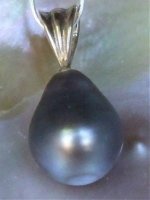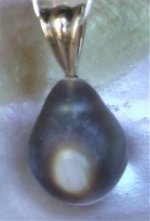Cathybear
Well-known member
- Joined
- Jul 9, 2007
- Messages
- 332
Not sure where this should go, sorry.
A friend has had a pearl pendant for 4 years, and worn it often. The shop said it was a South Sea Pearl. I forgot to measure it when it was here to be photographed but I'd guess it's about 10mm x 8-9mm.
One side has developed a light patch, and since I could see slight lines I'd guess the nacre has worn off.
Can anyone suggest anything to stop more wear (apart from keeping it in a box 24/7), and could it be darkened again in any way?
One photo shows the good side, the other, the worn side
Cathy
A friend has had a pearl pendant for 4 years, and worn it often. The shop said it was a South Sea Pearl. I forgot to measure it when it was here to be photographed but I'd guess it's about 10mm x 8-9mm.
One side has developed a light patch, and since I could see slight lines I'd guess the nacre has worn off.
Can anyone suggest anything to stop more wear (apart from keeping it in a box 24/7), and could it be darkened again in any way?
One photo shows the good side, the other, the worn side
Cathy


